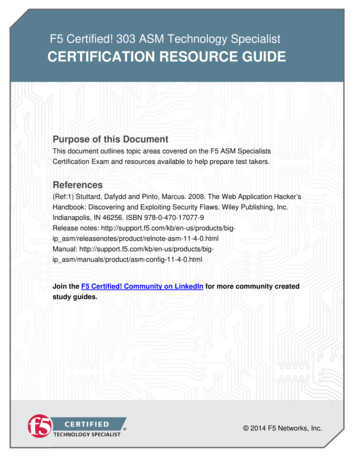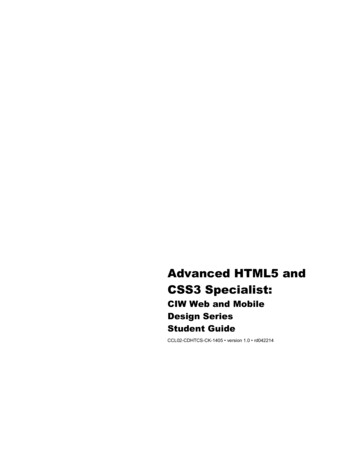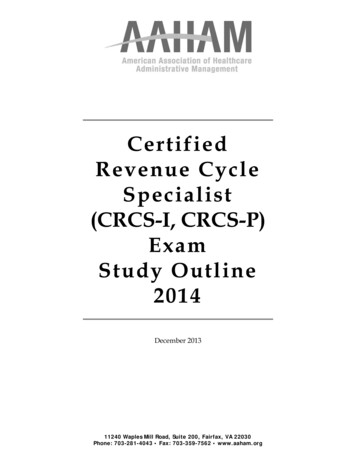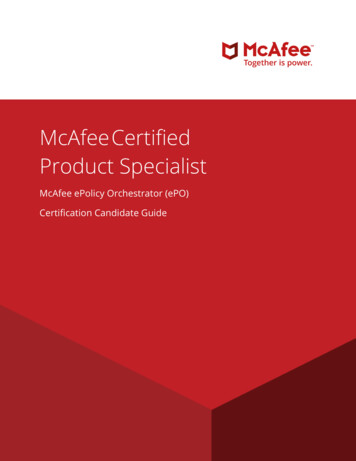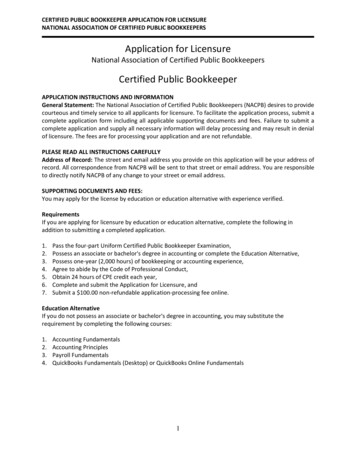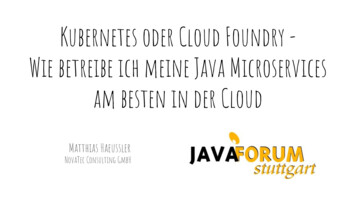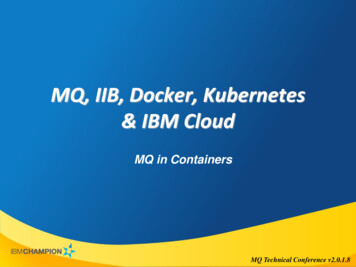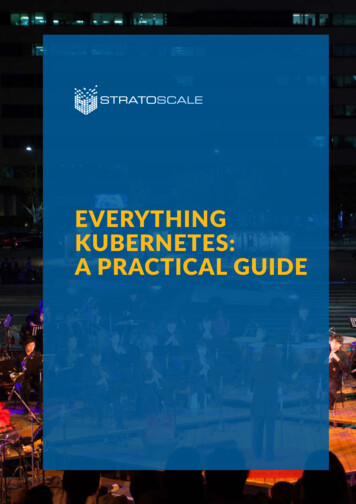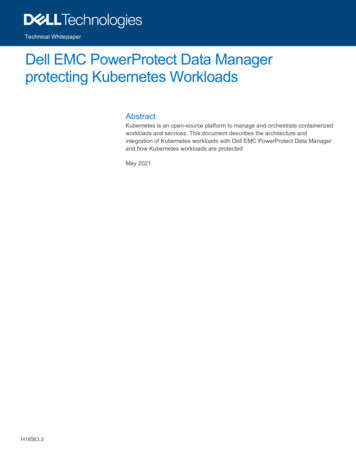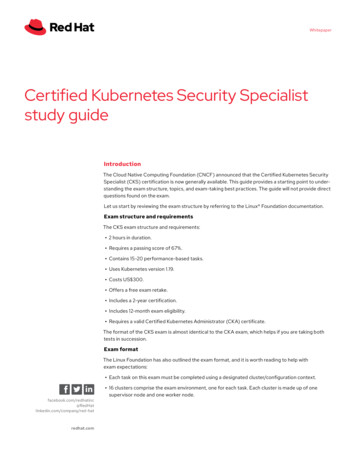
Transcription
WhitepaperCertified Kubernetes Security Specialiststudy guideIntroductionThe Cloud Native Computing Foundation (CNCF) announced that the Certified Kubernetes SecuritySpecialist (CKS) certification is now generally available. This guide provides a starting point to understanding the exam structure, topics, and exam-taking best practices. The guide will not provide directquestions found on the exam.Let us start by reviewing the exam structure by referring to the Linux Foundation documentation.Exam structure and requirementsThe CKS exam structure and requirements: 2 hours in duration. Requires a passing score of 67%. Contains 15-20 performance-based tasks. Uses Kubernetes version 1.19. Costs US 300. Offers a free exam retake. Includes a 2-year certification. Includes 12-month exam eligibility. Requires a valid Certified Kubernetes Administrator (CKA) certificate.The format of the CKS exam is almost identical to the CKA exam, which helps if you are taking bothtests in succession.Exam formatThe Linux Foundation has also outlined the exam format, and it is worth reading to help withexam expectations: Each task on this exam must be completed using a designated cluster/configuration company/red-hatredhat.com 16 clusters comprise the exam environment, one for each task. Each cluster is made up of onesupervisor node and one worker node.
At the start of each task, an infobox provides you with the cluster name/context and the supervisorand worker node’s hostname. You can switch the cluster/configuration context using a command such as: kubectl configusecontext. Nodes making up each cluster can be reached via ssh, using a command such as ssh. You don’t have elevated privileges on any node by default, so there is no need to assume elevatedprivileges. You must return to the base node (hostname CLI) after completing each task. Nested ssh is not supported. You can use kubectl and the appropriate context to work on any cluster from the base node.When connected to a cluster member via ssh, you will only work on that cluster via kubectl. Further instructions for connecting to cluster nodes will be provided in the appropriate tasks. The CKS environment is currently running Kubernetes v1.19. (Quarterly exam updates are plannedto match future Kubernetes releases.)Adding to the Linux Foundations format, there are a couple of extra notes to give more context: Vi/Vim is the default editor for the exam. If you require Gedit, Emacs, or Nano, it will have to beinstalled in each node you work on. Vi/Vim is preconfigured for the correct tabs/spaces required to format YAML files.With that context, it is time to discuss how to prepare for the exam.Preparing for the examTo help prepare for the CKS exam, StackRox (now owned by Red Hat) has created a GitHub Repo thatwill create a Kubernetes cluster using version 1.19 and provide Kubernetes security tasks to evaluate your expertise. The repo also contains a full library of resources to help guide you through eachsection of the exam and outline the core Kubernetes security topics.Getting started Register for the CKS at the Linux Foundation website. Follow the guidelines to book your exam, and set a date one to three months in advance. Read the complete Certified Kubernetes Security Specialist study guide. Follow the Kubernetes Security Specialist study guide GitHub repository and review the otherresources outlined in the README file to better understand various concepts.General tips for the examWith lessons learned from the CKA exam, here are some general tips and resources for dealing withthe performance- and task-based Kubernetes exams. Always review the Linux Foundation documentation for frequently asked questions and anyupdates to the exam structure.redhat.comWhitepaper Certified Kubernetes Security Specialist study guide2
Read each question carefully and manage the time accordingly. If a question asks for a pod, makesure to create a pod and not a deployment. The exam will evaluate on the basis of the outputs tofiles and deployment/pod names. Errors in filenames or pods names might cause the response tobe marked incorrect. Bookmark and use any resources from these domains and their respective subdomains: Kubernetes documentation and resources Kubernetes documentation Kubernetes GitHub Kubernetes blog Tools Trivy documentation Sysdig documentation Falco documentation AppArmor documentation Recording task progression will help to prioritize where to spend the final moments during the exam.In previous exams, a notepad was provided during the exam. In the new format, there is a progressbar and the ability to flag a question. You can use the flag to signal that you are completely finishedwith a question or to indicate you are unsure of its answer so you can revisit it later. Because time is of the essence, take advantage of the kubectl cheat sheet, and use aliases to cutdown on kubectl typos. Be proficient in vi/vim for file editing during the test. Luckily, the spacing is preformatted forYAML files. Pay attention to the question context. There will be a context change command at the beginning ofevery question. Since there are 16 unique clusters, make sure to address the correct cluster to usetime efficiently (and produce fewer headaches). Never write a YAML file from scratch. Use the –dry-run client -o yaml example.yamlto output example formats without submitting the commands to the cluster. With the new format,the YAML files are given with their bare bones formatting. It will be up to you to understand howto populate and apply them. Use the files available as they will give you a better understanding ofwhat is required of the question. Learn how to sort through JSON outputs. There might be a question where you are required tosearch through active pods/deployments for labels, memory limits, CPU limits, etc. You can save asignificant amount of time on a low-value question by sifting through objects efficiently. The exam will use kubeadm for creating the Kubernetes cluster. Review the systemd basics, andreview where the cluster configuration yaml files are located. When using ssh, ensure that you exit from the node to the central node.redhat.comWhitepaper Certified Kubernetes Security Specialist study guide3
The Linux Foundation is strict on the exam requirements and calls for an empty room, no visiblewriting materials, and a clean desk. Make sure to get a good night’s sleep, drink some water beforehand, take 30 minutes before the test to get up, walk around, and take a few deep breaths.During the examThe exam lasts for two hours, although there will be about 15 minutes of setup with the proctor beforethe exam starts. Once the exam starts, take your time in the first couple of minutes to get settled withthe test format. You are allowed two open windows, one for the exam and the other for using externalpages. Aim to complete questions in 5 minutes on average because there are approximately 15 questions and 120 mins to complete the exam. This will give you some time for review at the end of the test.The CKS, and Kubernetes exams in general, reward precision and time control. Rushing through thequestions might give you more time for review; however, a misconfiguration or typo in the YAMLfiles could lead to a loss of all points on a problem. It is better to be efficient the first time than toswitch contexts multiple times. Lastly, if you have no idea what the question is asking, we recommendmoving on to the next question. It is better to get a couple of questions answered correctly at thebeginning than wasting time on unknowns.Now that you understand the expectations, let us walk through the core exam concepts and topics.Section 1: Cluster setupThe first section focuses on controlling access to the Kubernetes cluster. The Linux Foundationcourse outline highlights these six core concepts:1.Use network policies to restrict cluster-level access.2.Use the CIS Kubernetes Benchmark to review the security configuration of Kubernetescomponents (etcd, kubelet, kube-dns, kube-api).3.Properly set up ingress objects with security control.4.Protect node metadata and endpoints.5.Minimize use of, and access to, GUI elements.6.Verify platform binaries before deploying.This section makes up 10% of the point total, and it is reasonable to assume there will be two or threequestions about cluster setup.Use network policies to restrict cluster-level accessNetwork access between Kubernetes pods is open internally by default. A significant security riskassociated with this setup is a container being able to access and connect to other workloads withinthe cluster network. Network policies are the answer to this core vulnerability, which means networkpolicies will, without a doubt, be on the exam.Network policies got an update in version 1.19, so it is worth reviewing the functionality and YAMLstructure changes. Also, make sure to bookmark these resources as they will come in handy for reference during the exam. If you’d like to learn more about network policies, Calico has some great demos,and Viswajith Venugopal has provided an extensive writeup of ingress and egress network policies. Lastly, our GitHub repo has multiple questions focused on default-deny policies and setting upingress objects.redhat.comWhitepaper Certified Kubernetes Security Specialist study guide4
Use the CIS Kubernetes Benchmark to review the security configuration ofKubernetes components (etcd, kubelet, kube-dns, kube-api)This topic is challenging to narrow down into specific questions. It requires knowledge of the CISbenchmarks that cover version 1.16 to 1.18. An open source tool, kube-bench, runs validation of theKubernetes components using the CIS benchmarks. It is worth knowing before the test; however, aquestion about kube-bench should not be on the test because the webpage is not a listed resourcethat can be used during the test. With the exam being created with Kubeadm, there might be questions focusing on fixing the core component config files such as kube-apiserver. Knowing how toconfigure and secure the Kubernetes components is vital to using functionality such as admissioncontrollers, role-based access control (RBAC), and avoiding a setup where --anonymous-auth wasset to true.Properly set up ingress objects with security controlKubernetes ingress is another concept that will be on the test. Questions could include adding TLSto a previous ingress object or setting up an IngressClass. IngressClass was introduced in version 1.18and helped to specify how different controllers should implement ingress objects. There are 3 typesof ingress controller setups to be aware of:1.Cluster-wide ingress controller (default)2.Single-namespace ingress controller3.Ingress controller for specific ingress classBe sure to understand how to implement TLS in Ingress objects and how to set up ingress objects andIngressClass objects.Protect node metadata endpointsThe topic says it all here. Protecting node metadata and endpoints is always a top concern. In previous Kubernetes versions, the kubelet had a read-only port, port 10255, that could be exploited tolearn more about the pods running on the worker nodes. There could be a question where you haveto reconfigure kubelet and disable the read-only port. However, the read-only capability has beendeprecated, so it seems unlikely this would come up. It is worth knowing all of the endpoints that arerequired for the Kubernetes cluster to function.Another use case might be a simple service check. There might be multiple services set up on theexam cluster, and then it is up to you to weed out unnecessary services and remove them. It will beworth brushing up on kubectl filtering capabilities and searching by spec.Minimize use of, and access to, GUI elementsSimilar to the previous concept, minimizing access to graphic user interface (GUI) elements is a significant security concern. This topic is fueled by previous security hacks that exposed the KubernetesDashboard to the public. To combat this issue, admins should set up internal-only facing dashboardswith specific user access outlined in their configuration files.There might be a question on the exam that requires changing NodePort services or proxying to adashboard. Another option could be minimizing the permissions of a dashboard within the cluster.Regardless, making sure that GUI elements are secure should always be a top priority duringcluster setup.redhat.comWhitepaper Certified Kubernetes Security Specialist study guide5
Verify platform binaries before deployingKubernetes binaries can be verified by referring to their specific checksum in GitHub. Because examtakers will have access to the Kubernetes GitHub repository, it is worth bookmarking the releasesection and understanding how to verify binary SHA256 hashes.Section 2: Cluster hardeningThe second section focuses on controlling access to the Kubernetes cluster environment. The LinuxFoundation highlights these four core concepts in their course outline:1.Restrict access to Kubernetes API.2.Use RBAC to minimize exposure.3.Exercise caution in using service accounts (e.g., disable defaults, minimize permissions on newlycreated ones).4.Update Kubernetes frequently.Knowing that this section makes up 15% of the point total, it is reasonable to assume there will be twoor three questions about cluster hardening.Restrict access to Kubernetes APIRestricting access to the API server is about 3 n control.The Kubernetes documentation outlines these topics well, and they are a recommended place tobookmark for the test. Restricting access to the Kubernetes API server is, and will remain, a prevalenttopic that will re-emerge in various concepts throughout the test.Starting with authentication, the CKS might contain a question on user and service account creationand might include creating user certifications or service accounts for deployments. The bootstraptokens feature probably will not be used due to the limitations of the environment setup.When it comes to authorization, the CKS will focus on RBAC configuration within the cluster as it isenabled by default today. However, there are other authorization modes to be aware of, including: Node authorization. Attribute-based access control (ABAC). Webhooks.With the time limitation, the questions around authorization will most likely focus on implementingRBAC policies and using auth can-i to determine API access.Lastly, admission control will continuously be in use throughout various CKS exam topics. Anadmission controller intercepts requests to the Kubernetes API after the request is authenticatedand authorized but before the object is saved in the key-value store. Know the default admissionredhat.comWhitepaper Certified Kubernetes Security Specialist study guide6
controllers in the current version, and we recommend bookmarking and getting to know each controller intimately. A significant amount of this exam will be working with various admission controllers tosecure the cluster. They will be highlighted as this study guide moves through the sections.Use RBAC to minimize exposureThis section is somewhat of a repeat of the previous concept, except that it focuses exclusively onRBAC. The concepts include: Roles. ClusterRoles. RoleBindings. ClusterRoleBindings.This concept will also highlight the binding of roles to “subjects” such as users, groups, and serviceaccounts. Expect questions focused on binding service accounts and users to specific access withinthe cluster.Exercise caution in using service accounts (e.g., disable defaults, minimizepermissions on newly created ones)This concept expands on the previous one and focuses on the proper implementation of subjects.This includes setting default service accounts with the lowest permissions and removing unnecessaryservice account permissions and using the auth can-i functionality to assess API access.Update Kubernetes frequentlyThe last topic was added during the detailed CKS announcement and is ambiguous about how this willbe tested. There might be an upgrade question as the documentation about upgrading with kubeadmhas been significantly better in recent releases. For instance, you must upgrade from version 1.18 to1.19 or possibly drain and update a single node on the cluster. This topic addition is most likely due toversion 1.15 being the average cluster version in production today and, in parallel, the community’sdesire to get users to take advantage of the updated security features in the last few releases.Section 3: System hardeningThe third section of our study guide focuses on minimizing the attack surface in the cluster as well askernel access. The Linux Foundation highlights these four core concepts in their course outline:1.Minimize host OS footprint (reduce attack surface).2.Minimize identity and access management (IAM) roles.3.Minimize external access to the network.4.Appropriately use kernel hardening tools such as AppArmor or seccomp.This section makes up 15% of the point total, and it is reasonable to assume there will be three or fourquestions about system hardening.Minimize host OS footprint (reduce attack surface)Minimizing the surface area of attack on your workloads is always an important task. There are 3 mainaspects to reducing the attack surface of your machines:redhat.comWhitepaper Certified Kubernetes Security Specialist study guide7
1.Removing unnecessary packages.2.Identifying and addressing open ports.3.Shutting down any unnecessary services.When applying this to the CKS exam, it is improbable that you will have to navigate the Ubuntu OSand remove packages during the exam. Instead, the CKS might ask you to stop containers runningwith privileged permissions in the cluster. Also, CronJob can pose a serious threat around persistenceand container exploitation that the CKS might try to highlight as well.Network policies are the default network segmentation tool in Kubernetes. It is unlikely that you willhave to use a tool like ufw to secure the host, although do not rule it out. Most likely, you will have toshut down exposed services and set up default deny rules inside Kubernetes namespaces to minimizenetwork access.The exam might also ask you to use admission controllers to limit what can and cannot be run in thecluster. Security contexts are used for multiple security aspects, such as setting process UIDs and notallowing write access to the container filesystem. Controllers such as SecurityContextDeny areuseful tools for limiting the scope of pod processes as well.Minimize IAM rolesTypically, identity and access management (IAM) roles are referenced when talking about cloud providers. Although it is not apparent how this concept will manifest during the exam, you can be surethat minimizing access through RBAC will be a consistent theme.Minimize external access to the networkMinimizing external access is a slight repetition of the first concept. You might see the network policyimplementation expand to include IP blocks and specific ingress and egress rules. Also, you mightbe required to investigate PodSecurityPolicies (PSP) that allow access to the host network or otherprivileges that might give a container elevated access. However, implementing PSPs during the examis unlikely, considering that the feature will most likely be deprecated in version 1.21.Appropriately use kernel hardening tools such as AppArmor and seccompThe documentation for the CKS changes frequently, and as of this writing, it allows you to accessAppArmor documentation during the exam. There is no link to seccomp documentation, but seccompprofiles have been a GA feature since 1.19. There is concern over how these concepts will be implemented during the exam. There is a lot of documentation to sift through, and a question on AppArmorimplementation might be a time sink if you are not careful. Most likely, there will be a question whereyou will implement a pre-configured AppArmor profile on the host or using an annotation.Section 4: Minimize microservice vulnerabilitiesThe fourth section of our study guide focuses on minimizing microservice vulnerabilities and securingpods at runtime. The Linux Foundation highlights these four core concepts in their course outline:redhat.com1.Set up appropriate OS-level security domains using options such as pod security policies (PSP),open policy agent (OPA), and security contexts.2.Manage Kubernetes secrets.3.Use container runtime sandboxes in multitenant environments (e.g., gvisor, kata containers).Whitepaper Certified Kubernetes Security Specialist study guide8
4.Implement pod-to-pod encryption using mTLS.This section makes up 20% of the point total, and it is reasonable to assume there will be three to fivequestions about minimizing microservice vulnerabilities.Set up appropriate OS-level security domains using options such as pod securitypolicies, open policy agent, and security contextsOverall, this section is the most vague regarding its concepts and what will be asked during the exam.As mentioned previously, pod security policies (PSPs) will be deprecated in Kubernetes version1.21, and open policy agent (OPA) documentation is not listed as a resource used during the exam.Security contexts are here to stay, and you should be well-versed in their implementation. While PSPsand OPA are useful to know about, it is not clear how they will be incorporated into the exam. Therewill most likely be a question about implementing a PSP through RBACs.Pod security policiesEven though PSPs will be deprecated, their functionality within Kubernetes clusters should be wellunderstood. PSPs are a cluster-level resource that control a wide variety of items, from Linux capabilities to UIDs. Unfortunately, one criticism is their confusing application through RBAC and subtleloopholes that can be exploited. PSPs are applied to the user and any pods they create, which meansyou need to be familiar with cluster-level roles to users, groups, and service accounts. You must alsobe aware of the various controls under the PSP and use the auth can-i functionality to help debugany authorization issues.Open policy agentOPA has been integrated into the Kubernetes admission controller framework since version 3.0. Thedocumentation is scant, so assume that if there is a question about it, it will be pulled directly from theblogs on kubernetes.io.Security contextSecurity context refers to the PodSpec and the permissions associated with each pod. Contexts canbe set at the pod and container level, and a question focused on debugging and identifying escalatingprivileges is a simple example that might be used. Overall, any questions around security contexts aregoing to tie into topics such as seccomp and AppArmor from the previous section and other privilegeand access control settings.Manage Kubernetes secretsIf you are taking the CKS, it means you have passed the CKA. You have already had to deal withsecrets management from the first exam, so expect expanding that core concept here. Examples thatfocus on service account tokens or bootstrap token secrets seem like the next steps. As mentionedin this section, you can also guarantee that TLS secrets overlap with other core security concepts.Overall, focus on knowing how to implement secrets securely and ensure that other containers cannotaccess the secrets.redhat.comWhitepaper Certified Kubernetes Security Specialist study guide9
Use container runtime sandboxes in multitenant environments (e.g., gvisor, katacontainers)It is essential to understand container runtime sandboxes and their use cases. There might be a question on the exam asking you to implement a sandbox using the runtimeClassName: spec. Theexam would have to provide you with gvisor or kata containers enabled in the cluster. The main issueis the lack of documentation from the list of sources you can reference during the exam.Implement pod-to-pod encryption using mTLSmTLS is a core concept to securing pod-to-pod communications. Although there might be anexample that combines secrets, ingress, and mTLS into a single larger question. It is unlikelythat the exam will ask you to create the certificates. However, it is worth bookmarking certificatesigning requests and understanding how to implement kubeconfig access and mTLSauthentication credentials.Section 5: Supply chain securityThe fifth section of our study guide focuses on supply chain security. The Linux Foundation highlightsthese four core concepts in its course outline:1.Minimize base image footprint.2.Secure your supply chain: put registries on the allowlist, sign, and validate images.3.Use static analysis of user workloads (e.g., Kubernetes resources, Dockerfiles).4.Scan images for known vulnerabilities.This section makes up 20% of the point total, and it is reasonable to assume there will be three to fivequestions about supply chain security.Minimize base image footprintRegardless of how this is implemented on the test, minimizing your base images is always a good ideato decrease the attack surface of your containers. Always make sure only to include the packagesthat are necessary for each containerized application. When choosing a base image, note how wellmaintained the image is and its default installed software. On the exam, expect that you will have theoption of selecting from a range of base images and choosing their defaults. There might be a question requiring Trivy to view CVEs related to a base image and then prioritize image selection accordingly. As a core concept, image scanning and minimizing your images is a handy way to lower theattack surface of your clusters.Secure your supply chain: allow permitted registries, sign and validate imagesSecuring the images that are allowed to run in your cluster is essential. Also, you will need to verifythat the pulled image is from the correct source. The ImagePolicyWebhook admission controllerwill allow you to set up rules around what images should be allowed within the cluster. An example rulethe admission controller could monitor is not allowing any image with the tag latest. You will mostlikely have to connect the ImagePolicyWebhook with a previously set up webhook server duringthe exam.redhat.comWhitepaper Certified Kubernetes Security Specialist study guide10
Use static analysis of user workloads (e.g., Kubernetes resources, Dockerfiles)Static analysis might be the most straightforward concept outlined in the Linux Foundation courseoutline. You will need to vet the configuration of Kubernetes YAML files and Dockerfiles and fix anysecurity issues. This includes setting secure base images, removing unnecessary packages, stoppingcontainers from using elevated privileges, and removing the ability to ssh into a container. When hardening Kubernetes resources, look for elevated privileges, security contexts that allow for a UID of 0,and host volumes that should not be mounted.Scan images for known vulnerabilitiesAs mentioned in the previous section, there seems to be some crossover between these two topics.Out of the open source tools that are allowed, Trivy is the only one focused on container scanning.You are also allowed to use the GitHub documentation during the exam, so it’s worth bookmarkingthe quick start documentation.Section 6: Monitoring, logging, and runtime securityOur study guide’s sixth and final section focuses on monitoring, logging, and runtime security withinthe cluster. The Linux Foundation highlights these six core concepts in its course outline:1.Perform behavioral analytics on syscall process and file activities at the host and container level todetect malicious activities.2.Detect threats within a physical infrastructure, apps, networks, data, users, and workloads.3.Detect all phases of attack regardless of where it occurs and how it spreads.4.Perform deep analytical investigation and identification of bad actors within the environment.5.Ensure immutability of containers at runtime.6.Use audit logging to monitor access.This section makes up 20% of the point total, and it is reasonable to assume there will be three to fivequestions about monitoring, logging, and runtime security.Perform behavioral analytics on syscall process and file activities at the host andcontainer level to detect malicious activitiesTo perform behavioral analysis of syscall and file activities, you will need to implement a tool to detectthreats. Falco is a CNCF incubating project listed in the course documentation as a resource availableduring the exam. Assume that you will have to use Falco to detect some malicious activity and outputit to a file, similar to questions from the CKA.Detect threats within a physical infrastructure, apps, networks, data, users, andworkloadsThis concept generalizes a lot of previous topics covered in past blogs. Assuming that each of thequestions takes an average of five to six minutes, it is unlikely the exam will have complicated problems that cannot be solved relatively quickly. One possibility might require you to fully assess adeployment in the cluster and write any vulnerabilities that are found in a file. The exam seeks todetermine your knowledge of Kubernetes security threats and how to mitigate them. This conceptseems overly broad to narrow it down to any specific topic.redhat.comWhitepaper Certified Kubernetes Security Specialist study guide11
WhitepaperDetect all phases of attack regardless of where it occurs and how it spreadsThis is another somewhat broad concept; however, it does highlight various methods of exploitation.Mounted volumes, downloading packages, or using malicious running containers on the host exposea significant attack surface that you need to be aware of. There is an excellent blog series focused onthe MITRE ATT&CK Framework, which is a great resource for reviewing relevant threa
redhat.com Whitepaper Certified Kubernetes Security Specialist study guide 2 At the start of each task, an infobox provides you with the cluster name/context and the supervisor and worker node’s hostname. You can switch the cluster/configuration context using a command such as: kubectl config usecontext. Nodes

